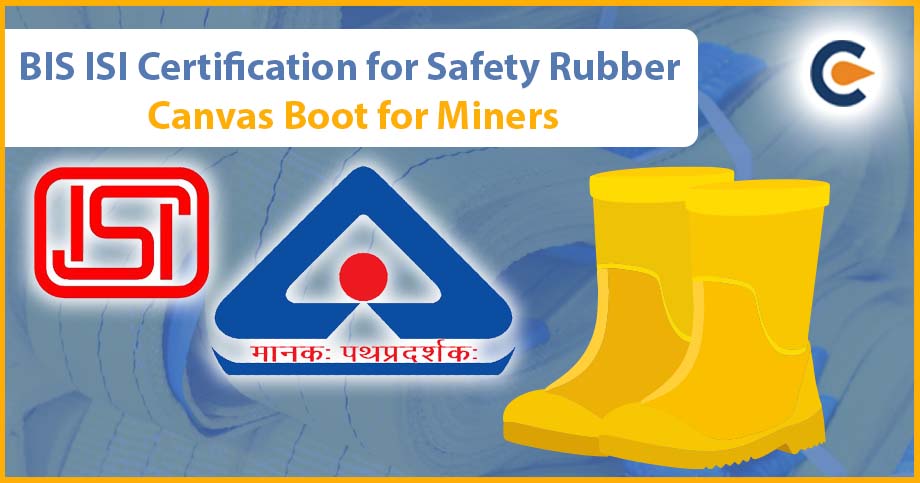Safety Rubber Canvas Boot plays a vital role in providing the required safety and comfort to the miner’s foot. The manufacturers of such footwear are required to comply with the quality and testing guidelines of IS 3976:2018. Also, these norms serve as a basis for securing the BIS ISI certification, which enables manufacturers to affix ISI marking on their products. Let’s understand what these requirements are and how you can secure BIS ISI certification for Safety Rubber Canvas Boot.
IS 3976:2018 Norms for BIS ISI Certification for Safety Rubber Canvas Boot
IS 3976:2018 is an Indian Standard that was prepared under the supervision of industry experts and SMEs. This standard specifies the quality, testing, and sample guidelines for Safety Rubber Canvas Boots for Miners comprising a protective steel toe cap.
This standard encompasses two types of miner safety boots namely Type 1 and Type 2. This categorization is specified on the basis of the performance guidelines cited in the standard. Let’s see what these types entail.
- Type 1: Boots are ideal for miners and work environments that experience water accumulation or slurry. The slurry-prone areas must not have a water level exceeding ankle height.
- Type 2: Boots are suitable for miners who work in dry mining environments.
The manufacturers of these boots should not choose construction materials other than those cited in the IS 3976:2018.
This standard pens down the material and thickness guidelines corresponding to the various components. The design concerning Type 1 and 2 should meet the standard norms without fail.
The manufacturer should test their products in a lab outfitted with apt equipment and well-trained staff. The procedures for how these test should be performed is cited in the standard.
Both types adhere to different testing requirements as per the standard and thus manufacturers should address them separately if they wish to produce either product in their facility.
Mandatory Testing For Safety Rubber Canvas Boot
Tests that should be undertaken by the manufacturers are as follow:
- Water Vapour Permeability Test,
- Tear Strength Test,
- Consolidation Test
- Resistance to Hot Contact of Sole Heel
- Breaking Strength Test
- Abrasion Resistance Test
- Absorption Test
- Flexing Test
- Impact Test
Labeling Norms under BIS ISI Certification for Safety Rubber Canvas Boot
Each finished boot should be marked with the following particulars without fail by the manufacturer:
- Size
- Manufacturing Month And Year
- Trademark
- ISI mark
The use of ISI marking is not possible without a BIS license, which is granted by the Bureau of Indian Standards after a successful assessment of the production process, quality control, and testing capabilities of the applicant’s firm.
Paperwork for the BIS ISI Certification for Safety Rubber Canvas Boot
Following are some vital documents required for BIS ISI certification for Safety Rubber Canvas Boot:
- Factory license
- A Business registration document such as a partnership deed, incorporation certificate, etc.
- Listicle concerning the equipment present in the in-house lab.
- Specimen testing report issued by the BIS-recommended lab
- List of products for which ISI registration is required
- List of machinery available at the production facility
- Trademark registration if available
- Authorization letter granted by the head of the company authorizing an agent to file an application.
- Production process flowchart
Steps for Obtaining BIS ISI Certification for Safety Rubber Canvas Boot
Hopefully, by now you have a brief idea of what IS 3976:2018 is all about. The section below unveils the process of securing the BIS ISI certification for safety rubber canvas boot in detail.
Step 1: Head to the BIS Portal to File an Online Application
The process of securing BIS ISI certification begins with online application filing. The application concerning the BIS license is available on the BIS portal. Upon locating the application, you can start filling the same with the details concerning the production facility, products being produced, and an in-house lab. The portal will prompt you to upload the documents (as listed above) as soon as you finish the filling requirement. Your last step in this phase of the process will be the fee submission, which you can complete by reaching the payment window. Once done, be ready for the subsequent step, which is the onsite inspection and document vetting.
Step 2: Vetting Of Documents and Sample Selection
Upon receiving the documents, the specific department of BIS will initiate the testing process, which would involve on-site inspection and sample collection.
During their on-site visit, the BIS official[1] will vet the following for the compliance fulfilment:
- Manufacturing Infrastructure
- Production process
- Testing capabilities
- Standard(s) being followed
Once done, the officials will proceed to collect some samples, which will undergo testing requirements (as cited above) for quality assurance.
Step 3: Specimen Testing and Report Generation
The selected sample will undergo the following tests performed by the lab for quality assurance. Only the qualified products shall bear the ISI marking as per the BIS standards.
- Water Vapour Permeability Test,
- Tear Strength Test,
- Consolidation Test
- Resistance to Hot Contact of Sole Heel
- Breaking Strength Test
- Abrasion Resistance Test
- Absorption Test
- Flexing Test
- Impact Test
Once these tests are performed by the lab successfully, the report generation will come into effect. The said report will enclose the lab’s observation and testing outcomes.
Step 4: Collection of a Report
The successful preparation of the report will lead to the next step in which the lab will inform the applicant to collect the report.
The applicant, in response, must collect the same and share it with the authority as soon as possible.
The late submission of the report can lead to the cancellation of the application as it adheres to limited validity.
Step 5: Lab Report Review and Grant of Certificate
In this step, the authority will probe the lab report for any potential non-conformity if any, and share the same with the applicant.
Based on how selected samples have performed during the testing, the authority will decide whether or not to accord the BIS ISI registration.
Conclusion
BIS ISI certification for Safety Rubber Canvas Boot serves as a mandatory legal permit. After securing a BIS license, the footwear makers can affix the ISI making on their products in a way as cited in the governing standard. Let us know if you experience any issues regarding compliance fulfillment. We will be obliged to help you out.
Also Read:
How To Obtain BIS Certification In India?
BIS ISI Certification For Ordinary Portland Cement
An Overview Of BIS ISI Mark For Cement Manufacturers













